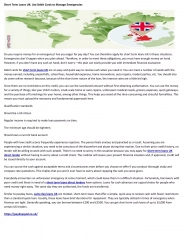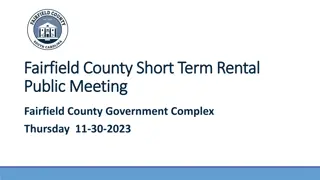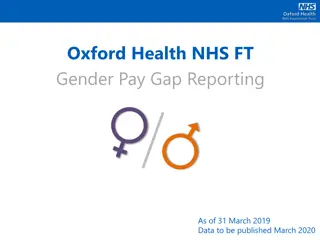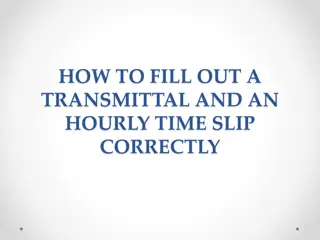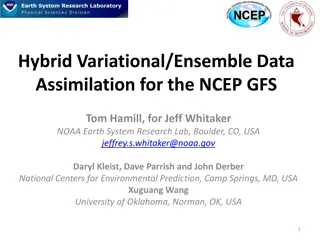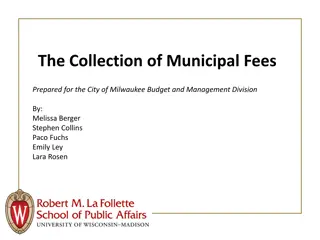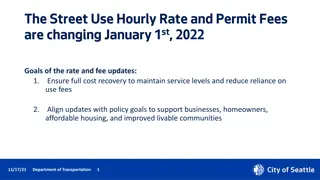Hourly Short-Term Ensemble for Milwaukee/Sullivan, WI
Observations and models are blended to create an hourly short-term ensemble forecast for Milwaukee/Sullivan, WI. The ensemble includes elements like temperature, dew point, wind, precipitation, and more, providing valuable data for up to 24 hours ahead. Various models and observations are used in the composition, ensuring a comprehensive and accurate forecast.
Download Presentation

Please find below an Image/Link to download the presentation.
The content on the website is provided AS IS for your information and personal use only. It may not be sold, licensed, or shared on other websites without obtaining consent from the author.If you encounter any issues during the download, it is possible that the publisher has removed the file from their server.
You are allowed to download the files provided on this website for personal or commercial use, subject to the condition that they are used lawfully. All files are the property of their respective owners.
The content on the website is provided AS IS for your information and personal use only. It may not be sold, licensed, or shared on other websites without obtaining consent from the author.
E N D
Presentation Transcript
CONSShort: an hourly short term ensemble for ESTF Jerry Wiedenfeld, ITO MKX Jeff Craven, SOO MKX CRGMAT/VTF NWS Milwaukee/Sullivan WI
Outline Background Information: Observations Models Blending of current obs into model consensus Nowcast feature PoP calibration differences versus CONSAll Hourly Weather, QPF, Snow, and Ice grids
Background: Composition of obs Five background fields, with observations matched via Tim Barker GFE serp program 20% LAPS (4 km) 20% RAP (13 km) {still RUC13 in AWIPS} 20% HRRR (3 km) 20% RTMA (5 km) 20% NAM12 (12km)
Model Info Each CONS Product is run every hour and produces hourly data out to 24 hours for the following elements T, Td, RH, Wind, WindGust, Sky, PoP, QPF, SnowAmt, Ice Accumulation, Wx 3, 6, and 12 hourly elements are computed for PoP, QPF, and SnowAmt
Composition of CONSShort Official Obs (advected by RAP 850-700-500 mb mean wind: PoP, Sky, QPF, Snow) Persistence/obs (all others) adjusted by 7 day mean diurnal hourly variation HRRR (3km - weighted four times) RAP (RUC13 weighted twice) GLAMP (2.5 km weighted twice) Local wsWRF (4km weighted twice) *this will vary if you don t have wsWRF WRF ARW (4km) WRF NMM (4km) NAM12 NAMDNG5 (5km) ADJLAV (RAP adjusted by LAMP stations) (weighted four times) ADJMET (NAM12 adjusted by MET stations) ADJMAV (GFS40 adjusted by MAV stations)
Composition of CONSShort (PoP, QPF, Sky, Snow) Model Weight Fhr 6 1 2 3 4 5 Official Obs/persistence HRRR RAP GLAMP Local wsWRF 9%* WRF ARW WRF NMM NAM12 NAMDNG5 0.5% 90% 2% 1% 1% 1% 75% 5% 2% 2% 1%* 2% 60% 8% 4% 4% 2%* 3% 40% 12% 6% 6% 4%* 4% 20% 16% 8% 8% 6%* 4% 10% 17% 9% 9% 8%* 0.5% 0.5% 0.5% 0.5% 1% 1% 1% 1% 2% 2% 2% 2% 3% 3% 3% 3% 4% 4% 4% 4% 4% 4% 4% 4%
Composition of CONSShort (T, Td, wind, wind gust, RH) Model Weight Fhr 6 1 2 3 4 5 Official Obs/persistence HRRR RAP GLAMP Local wsWRF 10%* WRF ARW WRF NMM NAM12 NAMDNG5 2% 4% 4% 5% 5% 5% 50% 10% 5% 5% 25% 14% 7% 7% 5%* 10% 17% 9% 9% 7%* 0 20% 10% 10% 9%* 0 20% 10% 10% 10%* 0 20% 10% 10% 10%* 2% 2% 2% 2% 4% 4% 4% 4% 4% 4% 4% 4% 5% 5% 5% 5% 5% 5% 5% 5% 5% 5% 5% 5%
Composition of CONSShort Model Approximate Weight in 7-24 hour period 7-15 16-18 7% 0% 0% 19% NA 10% 13% 10% 13% 10%* NA 5% 7% 5% 7% 5% 7% 5% 7% 19% 27% 5% 7% 19-24 8% 0% NA NA 15% NA 8% 8% 8% 8% 31% 8% Official 5% Obs/Persistence HRRR RAP GLAMP Local wsWRF WRF ARW WRF NMM NAM12 NAMDNG5 ADJLAV ADJMET
Resolution and Refresh rate Model Resolution Length Refresh frequency Official Obs/Persistence 1 -- HRRR 1 15 1 RAP 1 18 1 GLAMP 1 24 1 Local wsWRF 1 15* 3* WRF ARW 3 24+ 6 WRF NMM 3 24+ 6 NAM12 3 24+ 6 NAMDNG5 3 24+ 6 ADJLAV 1 24 1 1 hr 24+ hr ~3 hr 1
Bias Correction BOIVerify does a 30 day bias correction every 3 hours BCCONSShort harnesses the 3 hour bias corrected grids, and then does weighted time interpolation to get hourly values Since BOIVerify starts 12 hours into the future, BOIShort was created to handle 0-12 hour hourly grid verification. It runs every 3 hours out 12 hours BOIShort is not included in CONSShort Tech Note (due to database size issues)
Temperature and Dew Point Hourly temperatures are used if available For those inputs that are 3 hour temporal resolution, a weighted time interpolation is used to compute additional hours The observation contribution for the next 3 hours is adjusted based on the 7 day running average diurnal change. That way, a 15z observed Temp would be adjusted up, e.g. 3 degrees to be used as a 16z input
Wind Wind is treated like T and Td Bias Correction of the wind is only on the speed, not the direction The weighted time interpolation for 3 hourly inputs works like T and Td, but does account for both direction and speed The wind observations are adjusted for 7 day running means, so it should have some diurnal effects as well
Wind Gust Similar to wind Smart Inits are used to create Wind Gust for models that don t specifically generate it The transport wind magnitude is compared to the Gust Factor looking at the 10 meter wind speed. If the transport wind is within 1.3 to 1.8 range, the transport wind magnitude is used for wind gust. If not, it is capped with lower bound of 1.3 and upper bound of 1.8 times the 10 meter wind In all other cases, Wind Gust = 1.5 x 10m wind The Wind Gust QC ensures that Gust > wind
Relative Humidity The model RH is used for 2 meter level Possible changes: taking the consensus T and Td, and computing a consensus RH to save computing time in the future
Sky This field needs work, since we still use sky cover from RH Smart Init. This will improve if we replace these Smart Inits with actual cloud cover generated from model cloud The MOS components do help out here For observations, the average of obs , LAPS, and RTMA is used. Obs include METARs. This is advected into the future each hour by the mean RAP wind in 850/700/500mb layer
PoP Weighted Observed grid is used hours 0-6 100%, 90%, 75%, 60%, 40%, 20%, 10% The Obs grid is advected using an average of the forecasted RAP winds at 850, 700, and 500 mb Since many models do not have hourly PoP, QPF was used to generate an hourly PoP Took QPF over its period and fragmented the grid to hourly QPF If QPF > .01 PoP=100%, otherwise 0% (not same as CONSALL method which is tied more to QPF amount) Run a smoother over the final CONSField Produces 1, 3, 6, and 12 hour PoP, which are consistent
Examples hourly PoP 0 hour 2 hour 4 hour
QPF Observed grid is created by taking highest value of LAPS, MPE, RTMA. If those are all missing, then the HRRR QPF is used as a starting point. (Great need for better Hourly Precip Analysis) Weighted Observed grid is used hours 0-6 100%, 90%, 75%, 60%, 40%, 20%, 10% The Ob grid is advected using an average of the forecasted RAP winds at 850, 700, and 500 mb Since many models do not have hourly QPF, Took QPF over its period and fragmented the grid to hourly QPF Produces 1, 3, and 6 hour QPF, which are consistent
Details of the nowcast feature From hours 7-24 of the forecast, the consensus of the available guidance is weighted just about equally with exception of HRRR and ADJLAV From hours 1-6, there is a heavy weight toward the current observations, which decreases each hour until it is gone at hour 7 For parameters like T, Td, wind, wind gust, the current observations are tweaked in the next 3 hours based on a 7 day running average of the diurnal hour to hour change (for example, you would not want to use a 15z T for 16z, because it would normally go up about 3 degrees)
Examples hourly QPF 0 hour 2 hour 4 hour
Details of the nowcast feature For parameters like Sky, PoP, QPF, and Snow: The observed Sky, QPF, and Snow are advected by the mean hourly RAP wind averaged from 850 mb, 700 mb, and 500 mb The PoP is derived from the QPF, which is a combination of the advected QPE and the model forecast QPF. This starts heavily weighted towards continuity, but then becomes more model driven as you approach 6 hour mark Snow is created from QPF, surface temperature, and the Caribou/Cobb derived Snow Ratio using the latest RAP during hours 1-18 then NAM12/GFS40 there after https://ams.confex.com/ams/pdfpapers/94815.pdf
SnowAmt Used CONS QPF and Temperature as well as RAP/GFS40/NAM12 consensus SnowRatio (Caribou/Cobb) to compute SnowAmt Weighted time interpolation is used for GFS40/NAM12 snow ratios First compute raw snow amounts by multiplying QPF by SnowRatio Post process based on temperature If T > 32, ((36-T)^2/16) x SnowAmt If T > 36 set to 0 Otherwise set to originally computed SnowAmt
18z run 02z KMSN 30F 1 -SN Obs Fcst KMKE 33F 2 -SN KMSN 0.01 0.2 0.4 0.02 0.2 0.1
The relationship between 1, 3, 6, and 12 hour grids in CONSShort The 1, 3, 6, and 12 hour grids are consistent Thus, adding up 6 hourly QPF grids will yield the same value as the QPF6 grid Adding up the 6 hourly SnowAmt grids will yield the same value as the SnowAmt6 grid
Ice Accumulation If there is hourly QPF but the hourly Snow Amount is zero, then locations with temperatures of 32F or colder will have that QPF assigned as ice accumulation This field is later used to determine Wx grids that include Freezing Rain
Weather Harnessed a variety of information: Snow Ratio (RAP/NAM12/GFS40) Snow amounts (CONSShort) Ice Accumulation (CONSShort) Surface Temperature (CONSShort) 850 mb Temperature (RAP/NAM12/GFS40) QPF (CONSShort) PoP (CONSShort) SBCAPE (RAP/NAM12/GFS40)
Weather If snow amount calculated, then precip type snow If no snow and temp 32F or less, then freezing rain with ice accumulation from QPF Several simple mixed algorithms that look at snow ratio, CONSShort surface temperature, and 850 mb temperature from RAP/NAM12/GFS40 to determine snow, sleet, freezing rain, and rain mixes If no snow or ice & temp above 33F, then rain when QPF >.01 Looks at consensus model SBCAPE to determine stratiform, showers, and thunder No fog or blowing snow (yet)
Examples hourly Wx 7 hour 10 hour 13 hour
Weather Matrix Snow or ice amt? Snow > 8:1 WX Snow Ratio Surface Temp 850 mb Temp SN <33F 33-36F <32F <32F <32F <32F <0C <0C 0-1C 0-1C 1-2C 0-0.5C RN/SN PL/SN PL FZRA/PL FZRA/PL/S N FZRA/PL FZRA RA/PL FZRA/RA 0 <8:1 0 0 0 Ice Ice Ice 0 0 <32F <32F 32-35F 32-33F 0.5-2C >2C <1C 1-2C <8:1 <8:1
Coming Features (AWIPS2) Aviation: Ceiling and Visibility Grids Improved Sky Cover Analysis from CIMSS Adding Fog, blowing snow, and freezing spray to Weather Adding Weather to CONSAll Adding Snow Ratio, Snow, and Ice to CONSAll BOIShort: Space an issue
Best Verifying Models at MKX per BOIShort Temp and Td: ADJLAV, CONSShort and BCCONSShort depending on time of day Wind and Wind Gust: BCCONShort very dominant. CONSShort often 2nd Sky: ADJLAV best. CONSShort often worst. Official has 15% high bias (Less confidence in Sky verification due to analysis quality)
Known Issues Lag/delay between HRRR running and being available in GFE is roughly 4-5 hours and causes spinup issues in precip/QPF The advection of features using 850/700/500 mb wind can cause poor results (e.g. Lake effect snow showers and orographic features) Non-diurnal events, especially in first 3 hours (e.g. frontal passage)
Summary CONSShort creates realistic hourly grids Detailed features are subject to usual model error and can be off a county or so and a few hours Observed hourly precip fields like LAPS, RTMA, MPE, RFCQPE could use additional work. These are critical for spinning up the PoP/QPF/Snow Lots of detail in time and space for QPF, PoP, Snow, Wx. Hard for some forecasters to embrace



